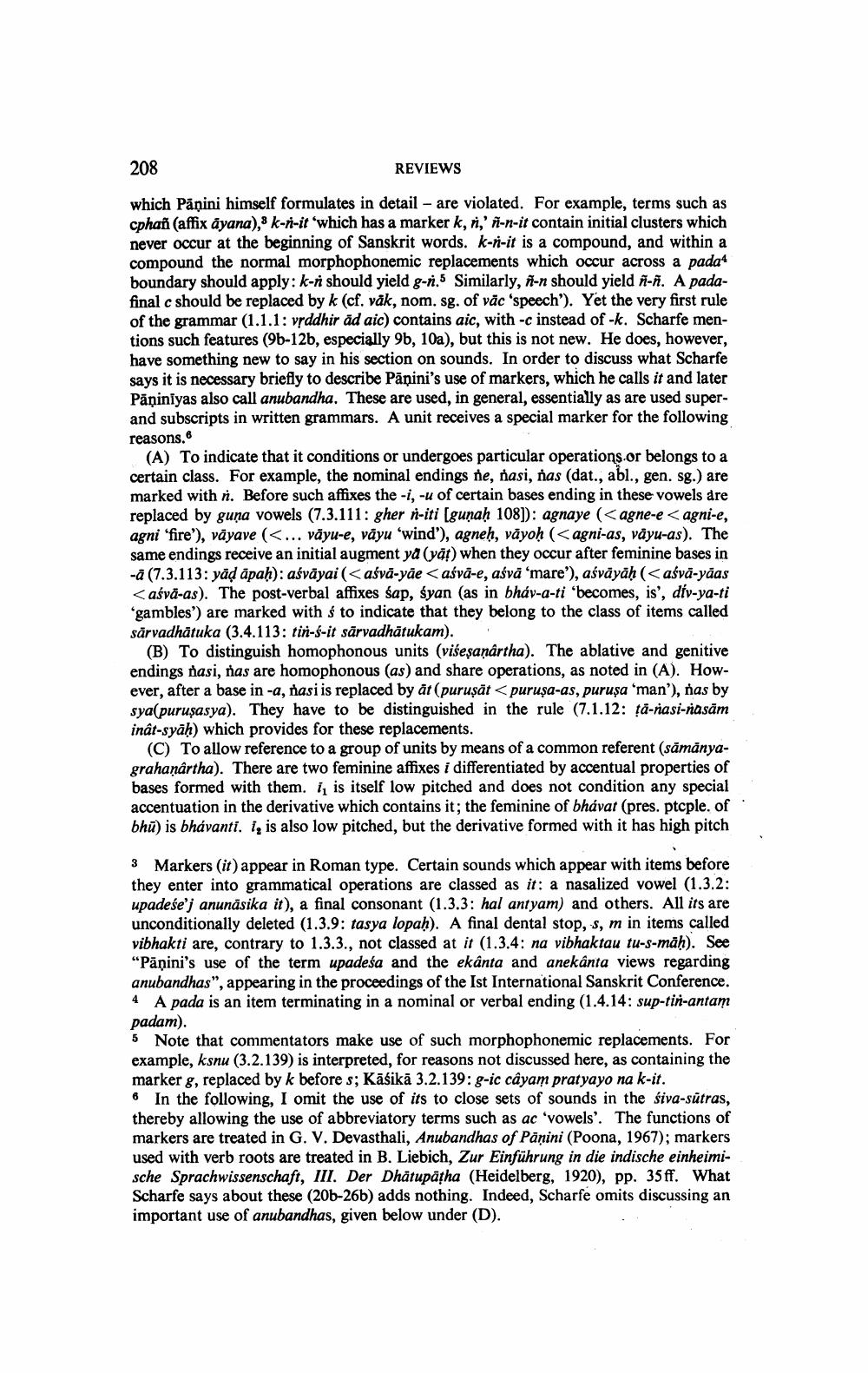Book Title: Reviews Of Different Books Author(s): Publisher: View full book textPage 2
________________ 208 REVIEWS which Panini himself formulates in detail - are violated. For example, terms such as cphan (affix ayana), k-r-it which has a marker k,r,' n-n-it contain initial clusters which never occur at the beginning of Sanskrit words. k-r-it is a compound, and within a compound the normal morphophonemic replacements which occur across a pada4 boundary should apply: k-r should yield g-r.5 Similarly, n-n should yield n-n. A padafinal c should be replaced by k (cf. vak, nom. sg. of vac 'speech'). Yet the very first rule of the grammar (1.1.1: vyddhir ad aic) contains aic, with -c instead of -k. Scharfe mentions such features (9b-12b, especially 9b, 10a), but this is not new. He does, however, have something new to say in his section on sounds. In order to discuss what Scharfe says it is necessary briefly to describe Panini's use of markers, which he calls it and later Paniniyas also call anubandha. These are used, in general, essentially as are used superand subscripts in written grammars. A unit receives a special marker for the following reasons. (A) To indicate that it conditions or undergoes particular operations.or belongs to a certain class. For example, the nominal endings ne, nasi, nas (dat., abl., gen. sg.) are marked with ". Before such affixes the -i, -u of certain bases ending in these vowels are replaced by guna vowels (7.3.111: gher n-iti [gunah 108]): agnaye (<agne-e < agni-e, agni 'fire'), vayave (< ... vayu-e, vayu 'wind'), agneh, vayoh (< agni-as, vayu-as). The same endings receive an initial augment ya (yat) when they occur after feminine bases in -a (7.3.113: yad apah): asvayai (<asva-yae <asva-e, asva 'mare'), asvayah (<asva-yaas <asva-as). The post-verbal affixes sap, syan (as in bhav-a-ti 'becomes, is', div-ya-ti 'gambles') are marked with s to indicate that they belong to the class of items called sarvadhatuka (3.4.113: tin-s-it sarvadhatukam). (B) To distinguish homophonous units (visesanartha). The ablative and genitive endings nasi, nas are homophonous (as) and share operations, as noted in (A). However, after a base in -a, nasi is replaced by at (purusat < purusa-as, purusa 'man'), nas by sya(purusasya). They have to be distinguished in the rule (7.1.12: ta-nasi-rasam inat-syah) which provides for these replacements. (C) To allow reference to a group of units by means of a common referent (samanyagrahanartha). There are two feminine affixes i differentiated by accentual properties of bases formed with them. i, is itself low pitched and does not condition any special accentuation in the derivative which contains it; the feminine of bhavat (pres. ptcple. of. bhu) is bhavanti. i, is also low pitched, but the derivative formed with it has high pitch 3 Markers (it) appear in Roman type. Certain sounds which appear with items before they enter into grammatical operations are classed as it: a nasalized vowel (1.3.2: upadese'j anunasika it), a final consonant (1.3.3: hal antyam) and others. All its are unconditionally deleted (1.3.9: tasya lopah). A final dental stop, s, m in items called vibhakti are, contrary to 1.3.3., not classed at it (1.3.4: na vibhaktau tu-s-mah). See "Panini's use of the term upadesa and the ekanta and anekanta views regarding anubandhas", appearing in the proceedings of the Ist International Sanskrit Conference. 4 A pada is an item terminating in a nominal or verbal ending (1.4.14: sup-tin-antam padam). 5 Note that commentators make use of such morphophonemic replacements. For example, ksnu (3.2.139) is interpreted, for reasons not discussed here, as containing the marker g, replaced by k before s; Kasika 3.2.139: g-ic cayam pratyayo na k-it. 6 In the following, I omit the use of its to close sets of sounds in the siva-sutras, thereby allowing the use of abbreviatory terms such as ac 'vowels'. The functions of markers are treated in G. V. Devasthali, Anubandhas of Panini (Poona, 1967); markers used with verb roots are treated in B. Liebich, Zur Einfuhrung in die indische einheimische Sprachwissenschaft, III. Der Dhatupatha (Heidelberg, 1920), pp. 35ff. What Scharfe says about these (206-26b) adds nothing. Indeed, Scharfe omits discussing an important use of anubandhas, given below under (D).Page Navigation
1 2 3 4 5 6 7 8 9 10 11 12 13 14 15 16 17 18 19 20 21 22 ... 33
